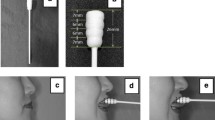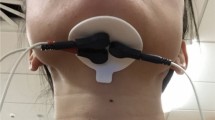Abstract
Submental surface electromyography (sEMG) may provide information about the lingual-palatal pressure (LPP) during swallowing. However, the extent to which changes in age and LPP levels are reflected in different sEMG measures is unclear. This study aimed to understand the effects of age and different levels of submaximal LPPs on submental sEMG peak, average, and integrated values in healthy adults. Ninety community-dwelling healthy participants were categorized into three age groups (young: 20–39 years, middle age: 40–59 years, older: 60 ≥ years). sEMG and LPP measurements were collected concurrently. After placing the sEMG electrodes, the maximal isometric LPP was established using the Iowa oral performance instrument (IOPI) on the anterior tongue. sEMG recordings were conducted for three submaximal LPP levels, including 40%, 60%, and 80% of the maximum LPP. Two-way repeated measure ANOVAs were conducted to find the effects of age and varying LPP levels on mean sEMG peak, average, and integrated measures. A significant age by LPP level interaction was identified for sEMG peak [F (4, 172) = 4.116, p < 0.007, ηp2 = 0.087], sEMG average [F (4, 170) = 5.049, p < 0.001, ηp2 = 0.106], and sEMG integrated values [F (4, 170) = 4.179, p < 0.003, ηp2 = 0.090]. Post hoc testing demonstrated that, in general, sEMG values significantly increased with rising LPP levels, primarily for younger and middle-aged adults. Furthermore, at 80% of maximum LPP, older adults generated less sEMG average and integrated values than middle age (only significant for sEMG integrated value) and younger adults. Likewise, max LPP was lower in older adults compared with young and middle-aged groups. Submental sEMG has the potential to be incorporated into a skill-based lingual exercise paradigm to improve tongue function during swallowing. Moreover, submental sEMG can characterize some age-related subclinical changes in swallowing.





Similar content being viewed by others
References
Takahashi N, Barikroo A, Crary MA, Dungan S, Carnaby GD. Transcutaneous electrical stimulation as a resistance force in lingual exercise: a preliminary proof-of-concept study. J Oral Rehabil. 2022;49:712–9. https://doi.org/10.1111/joor.13332.
Stierwalt JA, Youmans SR. Tongue measures in individuals with normal and impaired swallowing. Am J Speech Lang Pathol. 2007;16:148–56. https://doi.org/10.1044/1058-0360(2007/019).
Yoshida M, Kikutani T, Tsuga K, Utanohara Y, Hayashi R, Akagawa Y. Decreased tongue pressure reflects symptom of dysphagia. Dysphagia. 2006;21:61–5. https://doi.org/10.1007/s00455-005-9011-6.
Namasivayam AM, Steele CM, Keller H. The effect of tongue strength on meal consumption in long term care. Clin Nutr. 2016;35:1078–83. https://doi.org/10.1016/j.clnu.2015.08.001.
Lin CJ, Lee YS, Hsu CF, Liu SJ, Li JY, Ho YL, Chen HH. Effects of tongue strengthening exercises on tongue muscle strength: a systematic review and meta-analysis of randomized controlled trials. Sci Rep. 2022;12:10438. https://doi.org/10.1038/s41598-022-14335-2.
Smaoui S, Langridge A, Steele CM. The effect of lingual resistance training interventions on adult swallow function: a systematic review. Dysphagia. 2020;35:745–61. https://doi.org/10.1007/s00455-019-10066-1.
Benfield JK, Everton LF, Bath PM, England TJ. Does therapy with biofeedback improve swallowing in adults with dysphagia? A systematic review and meta-analysis. Arch Phys Med Rehabil. 2019;100:551–61. https://doi.org/10.1016/j.apmr.2018.04.031.
Sasegbon A, Hamdy S. The anatomy and physiology of normal and abnormal swallowing in oropharyngeal dysphagia. Neurogastroent Motil. 2017. https://doi.org/10.1111/nmo.13100.
Stepp CE. Surface electromyography for speech and swallowing systems: measurement, analysis, and interpretation. J Speech Lang Hear Res. 2012;55:1232–46. https://doi.org/10.1044/1092-4388(2011/11-0214).
Perry SE, Sevitz JS, Curtis JA, Kuo SH, Troche MS. Skill training resulted in improved swallowing in a person with multiple system atrophy: an endoscopy study. Mov Disord Clin Pract. 2018;5:451–2. https://doi.org/10.1002/mdc3.12628.
Athukorala RP, Jones RD, Sella O, Huckabee ML. Skill training for swallowing rehabilitation in patients with Parkinson’s disease. Arch Phys Med Rehabil. 2014;95:1374–82. https://doi.org/10.1016/j.apmr.2014.03.001.
Steele C, Bennett J, Chapman-Jay S, Polacco R, Molfenter M, Oshalla M. Electromyography as a biofeedback tool for rehabilitating swallowing muscle function. In: Steele C, editor. Applications of EMG in clinical and sports medicine. Rijeka: IntechOpen; 2012. p. 311–28.
Wilson EM, Green JR. Coordinative organization of lingual propulsion during the normal adult swallow. Dysphagia. 2006;21:226–36. https://doi.org/10.1007/s00455-006-9053-4.
Arakawa I, Igarashi K, Imamura Y, Muller F, Abou-Ayash S, Schimmel M. Variability in tongue pressure among elderly and young healthy cohorts: a systematic review and meta-analysis. J Oral Rehabil. 2021;48:430–48. https://doi.org/10.1111/joor.13076.
Lenius K, Carnaby-Mann G, Crary M. The relationship between lingual-palatal pressures and submental surface electromyographic signals. J Oral Rehabil. 2009;36:118–23. https://doi.org/10.1111/j.1365-2842.2008.01921.x.
Park T, Kim Y. Effects of tongue pressing effortful swallow in older healthy individuals. Arch Gerontol Geriatr. 2016;66:127–33. https://doi.org/10.1016/j.archger.2016.05.009.
Huckabee ML, Steele CM. An analysis of lingual contribution to submental surface electromyographic measures and pharyngeal pressure during effortful swallow. Arch Phys Med Rehabil. 2006;87:1067–72. https://doi.org/10.1016/j.apmr.2006.04.019.
Fujiwara S, Fujiu-Kurachi M, Hori K, Maeda Y, Ono T. Tongue pressure production and submental surface electromyogram activities during tongue-hold swallow with different holding positions and tongue length. Dysphagia. 2018;33:403–13. https://doi.org/10.1007/s00455-017-9865-4.
Oommen ER, Kim Y. Submental muscle activation during lingual tasks in healthy adults. J Nutr Health Aging. 2018;22:1133–7. https://doi.org/10.1007/s12603-018-1084-7.
Sura L, Madhavan A, Carnaby G, Crary MA. Dysphagia in the elderly: management and nutritional considerations. Clin Interv Aging. 2012;7:287–98. https://doi.org/10.2147/CIA.S23404.
Behan M, Moeser AE, Thomas CF, Russell JA, Wang H, Leverson GE, Connor NP. The effect of tongue exercise on serotonergic input to the hypoglossal nucleus in young and old rats. J Speech Lang Hear Res. 2012;55:919–29. https://doi.org/10.1044/1092-4388(2011/11-0091).
Clark HM, Solomon NP. Age and sex differences in orofacial strength. Dysphagia. 2012;27:2–9. https://doi.org/10.1007/s00455-011-9328-2.
Nicosia MA, Hind JA, Roecker EB, Carnes M, Doyle J, Dengel GA, Robbins J. Age effects on the temporal evolution of isometric and swallowing pressure. J Gerontol A Biol Sci Med Sci. 2000;55:M634-640. https://doi.org/10.1093/gerona/55.11.m634.
Mortimore IL, Fiddes P, Stephens S, Douglas NJ. Tongue protrusion force and fatiguability in male and female subjects. Eur Respir J. 1999;14:191–5. https://doi.org/10.1034/j.1399-3003.1999.14a32.x.
Nagai H, Russell JA, Jackson MA, Connor NP. Effect of aging on tongue protrusion forces in rats. Dysphagia. 2008;23:116–21. https://doi.org/10.1007/s00455-007-9103-6.
Robbins J, Hamilton JW, Lof GL, Kempster GB. Oropharyngeal swallowing in normal adults of different ages. Gastroenterology. 1992;103:823–9. https://doi.org/10.1016/0016-5085(92)90013-O.
Robbins J, Levine R, Wood J, Roecker EB, Luschei E. Age effects on lingual pressure generation as a risk factor for dysphagia. J Gerontol A-Biol. 1995;50:M257–62. https://doi.org/10.1093/gerona/50A.5.M257.
Todd JT, Lintzenich CR, Butler SG. Isometric and swallowing tongue strength in healthy adults. Laryngoscope. 2013;123:2469–73. https://doi.org/10.1002/lary.23852.
Utanohara Y, Hayashi R, Yoshikawa M, Yoshida M, Tsuga K, Akagawa Y. Standard values of maximum tongue pressure taken using newly developed disposable tongue pressure measurement device. Dysphagia. 2008;23:286–90. https://doi.org/10.1007/s00455-007-9142-z.
Yeates EM, Steele CM, Pelletier CA. Tongue pressure and submental surface electromyography measures during noneffortful and effortful saliva swallows in healthy women. Am J Speech Lang Pathol. 2010;19:274–81. https://doi.org/10.1044/1058-0360(2010/09-0040).
Yokoyama M, Mitomi N, Tetsuka K, Tayama N, Niimi S. Role of laryngeal movement and effect of aging on swallowing pressure in the pharynx and upper esophageal sphincter. Laryngoscope. 2000;110:434–9. https://doi.org/10.1097/00005537-200003000-00021.
Brates D, Molfenter S. The influence of age, eating a meal, and systematic fatigue on swallowing and mealtime parameters. Dysphagia. 2021;36:1096–109. https://doi.org/10.1007/s00455-020-10242-8.
Ng KB, Guiu Hernandez E, Erfmann KLC, Jones RD, Macrae P, Huckabee ML. Effect of volitional effort on submental surface electromyographic activity during healthy swallowing. Dysphagia. 2022;37:297–306. https://doi.org/10.1007/s00455-021-10278-4.
Humbert IA, German RZ. New directions for understanding neural control in swallowing: the potential and promise of motor learning. Dysphagia. 2013;28:1–10. https://doi.org/10.1007/s00455-012-9432-y.
Morrison S, Newell KM. Aging, neuromuscular decline, and the change in physiological and behavioral complexity of upper-limb movement dynamics. J Aging Res. 2012;2012:891218. https://doi.org/10.1155/2012/891218.
Crary MA, Carnaby Mann GD, Groher ME. Identification of swallowing events from sEMG Signals obtained from healthy adults. Dysphagia. 2007;22:94–9. https://doi.org/10.1007/s00455-006-9059-y.
Seidler RD, Bernard JA, Burutolu TB, Fling BW, Gordon MT, Gwin JT, Kwak Y, Lipps DB. Motor control and aging: links to age-related brain structural, functional, and biochemical effects. Neurosci Biobehav Rev. 2010;34:721–33. https://doi.org/10.1016/j.neubiorev.2009.10.005.
Faul F, Erdfelder E, Lang AG, Buchner A. G*Power 3: a flexible statistical power analysis program for the social, behavioral, and biomedical sciences. Behav Res Methods. 2007;39:175–91.
Crary MA, Mann GD, Groher ME. Initial psychometric assessment of a functional oral intake scale for dysphagia in stroke patients. Arch Phys Med Rehabil. 2005;86:1516–20. https://doi.org/10.1016/j.apmr.2004.11.049.
VanRavenhorst-Bell HA, Mefferd AS, Coufal KL, Scudder R, Patterson J. Tongue strength and endurance: comparison in active and non-active young and older adults. Int J Speech-Lang Pathol. 2017;19:77–86. https://doi.org/10.3109/17549507.2016.1154983.
Alves ICF, de Andrade CRF. Functional change in the pattern of swallowing through the performance of orofacial exercises. Codas. 2017. https://doi.org/10.1590/2317-1782/20172016088.
Maia AV, Furlan RMMM, Moraes KO, Amaral MS, de Medeiros AM, Motta AR. Tongue strength rehabilitation using biofeedback: a case report. Codas. 2019. https://doi.org/10.1590/2317-1782/20182018163.
Palmer PM, Jaffe DM, McCulloch TM, Finnegan EM, Van Daele DJ, Luschei ES. Quantitative contributions of the muscles of the tongue, floor-of-mouth, jaw, and velum to tongue-to-palate pressure generation. J Speech Lang Hear Res. 2008;51:828–35. https://doi.org/10.1044/1092-4388(2008/060).
Archer SK, Smith CH, Newham DJ. Surface electromyographic biofeedback and the effortful swallow exercise for stroke-related dysphagia and in healthy ageing. Dysphagia. 2021;36:281–92. https://doi.org/10.1007/s00455-020-10129-8.
Day S. Important factors in surface EMG measurement. Calgary: Bortec Biomedical Ltd publishers; 2002. p. 1–17.
Kuiken TA, Lowery MM, Stoykov NS. The effect of subcutaneous fat on myoelectric signal amplitude and cross-talk. Prosthet Orthot Int. 2003;27:48–54. https://doi.org/10.3109/03093640309167976.
Funding
ACP Syncrony® system and the sEMG electrodes used in this study were provided by Accelerated Care Plus Corporation, Reno, NV, USA. However, the company had no role in the study design, data collection, data analysis, data interpretation, or writing of the manuscript.
Author information
Authors and Affiliations
Corresponding author
Ethics declarations
Conflict of interest
The authors declare that they have no conflict of interest.
Ethical Approval
All procedures performed in studies involving human participants were in accordance with the ethical standards of the institutional and/or national research committee and with the 1964 Helsinki declaration and its later amendments or comparable ethical standards.
Informed Consent
Informed consent was obtained from all individual participants included in the study.
Additional information
Publisher's Note
Springer Nature remains neutral with regard to jurisdictional claims in published maps and institutional affiliations.
Rights and permissions
Springer Nature or its licensor (e.g. a society or other partner) holds exclusive rights to this article under a publishing agreement with the author(s) or other rightsholder(s); author self-archiving of the accepted manuscript version of this article is solely governed by the terms of such publishing agreement and applicable law.
About this article
Cite this article
Barikroo, A., Im, I., Crary, M. et al. Effects of Age and Lingual-Palatal Pressure Levels on Submental Surface Electromyography Measures. Dysphagia 38, 1277–1285 (2023). https://doi.org/10.1007/s00455-023-10553-6
Received:
Accepted:
Published:
Issue Date:
DOI: https://doi.org/10.1007/s00455-023-10553-6




